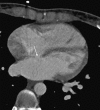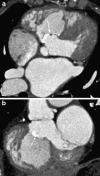Technical principles of computed tomography in patients with congenital heart disease
- PMID: 22347958
- PMCID: PMC3259356
- DOI: 10.1007/s13244-011-0088-1
Technical principles of computed tomography in patients with congenital heart disease
Abstract
Cardiac magnetic resonance imaging and echocardiography are often the primary imaging techniques for many patients with congenital heart disease (CHD). However, with modern generations of CT systems and recent advances in temporal and spatial resolution, cardiac CT has been gaining an increasing reputation in the field of cardiac imaging and in the evaluation of patients with congenital heart disease. The CT imaging protocol depends on the suspected cardiac defect, the type of previous surgical repair, and the patient's age and level of cooperation. Various strategies are available for reducing radiation exposure, which is of utmost importance particularly in paediatric patients. A sequential segmental analysis is a commonly used approach to analysing congenital heart defects. Familiarity of the performing radiologist with dedicated CT protocols, the complex anatomy, morphology and terminology of CHD, as well as with the surgical procedures used to correct congenital abnormalities is a prerequisite for correct diagnosis.
Figures



Similar articles
-
Role of computed tomography in adult congenital heart disease: A review.J Med Imaging Radiat Sci. 2021 Nov;52(3S):S88-S109. doi: 10.1016/j.jmir.2021.08.008. Epub 2021 Sep 2. J Med Imaging Radiat Sci. 2021. PMID: 34483084 Review.
-
Pre- and postoperative evaluation of congenital heart disease in children and adults with 64-section CT.Radiographics. 2007 May-Jun;27(3):829-46. doi: 10.1148/rg.273065713. Radiographics. 2007. PMID: 17495295 Review.
-
[Computed tomography for imaging of pediatric congenital heart disease].Radiologe. 2011 Jan;51(1):38-43. doi: 10.1007/s00117-010-1999-4. Radiologe. 2011. PMID: 21113571 Review. German.
-
Pictorial review of multidetector CT imaging of the preoperative evaluation of congenital heart disease.Curr Probl Diagn Radiol. 2013 Mar-Apr;42(2):40-56. doi: 10.1067/j.cpradiol.2012.06.001. Curr Probl Diagn Radiol. 2013. PMID: 23332137 Review.
-
Computed Tomography Imaging in Patients with Congenital Heart Disease Part I: Rationale and Utility. An Expert Consensus Document of the Society of Cardiovascular Computed Tomography (SCCT): Endorsed by the Society of Pediatric Radiology (SPR) and the North American Society of Cardiac Imaging (NASCI).J Cardiovasc Comput Tomogr. 2015 Nov-Dec;9(6):475-92. doi: 10.1016/j.jcct.2015.07.004. Epub 2015 Jul 23. J Cardiovasc Comput Tomogr. 2015. PMID: 26272851 Review.
Cited by
-
Complex adult congenital heart disease on cross-sectional imaging: an introductory overview.Insights Imaging. 2022 Apr 25;13(1):78. doi: 10.1186/s13244-022-01201-y. Insights Imaging. 2022. PMID: 35467233 Free PMC article. Review.
-
Comparison of 128-Slice Low-Dose Prospective ECG-Gated CT Scanning and Trans-Thoracic Echocardiography for the Diagnosis of Complex Congenital Heart Disease.PLoS One. 2016 Oct 27;11(10):e0165617. doi: 10.1371/journal.pone.0165617. eCollection 2016. PLoS One. 2016. PMID: 27788237 Free PMC article.
-
Diagnostic Validity and Reliability of Low-Dose Prospective ECG-Triggering Cardiac CT in Preoperative Assessment of Complex Congenital Heart Diseases (CHDs).Children (Basel). 2022 Dec 4;9(12):1903. doi: 10.3390/children9121903. Children (Basel). 2022. PMID: 36553346 Free PMC article.
-
The ascending aortic image quality and the whole aortic radiation dose of high-pitch dual-source CT angiography.J Cardiothorac Surg. 2013 Dec 12;8:228. doi: 10.1186/1749-8090-8-228. J Cardiothorac Surg. 2013. PMID: 24330784 Free PMC article. Clinical Trial.
-
Multidetector Computed Tomography (CT) in Evaluation of Congenital Cyanotic Heart Diseases.Pol J Radiol. 2017 Nov 17;82:645-659. doi: 10.12659/PJR.903222. eCollection 2017. Pol J Radiol. 2017. PMID: 29657630 Free PMC article.
References
-
- Moller JH, Taubert KA, Allen HD, Clark EB, Lauer RM. Cardiovascular health and disease in children: current status. A Special Writing Group from the Task Force on Children and Youth, American Heart Association. Circulation. 1994;89:923–930. - PubMed
-
- Goo HW, Park IS, Ko JK, Kim YH, Seo DM et al (2003) CT of congenital heart disease: normal anatomy and typical pathologic conditions. Radiographics 23:S147–S165 - PubMed
LinkOut - more resources
Full Text Sources
